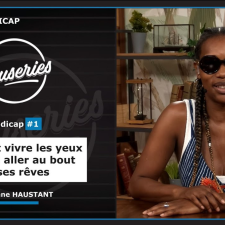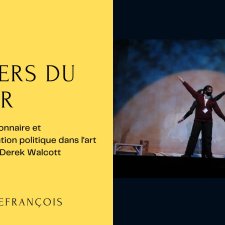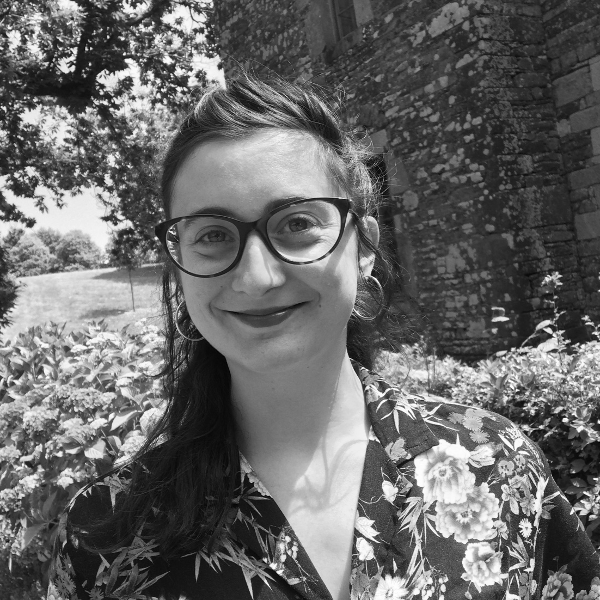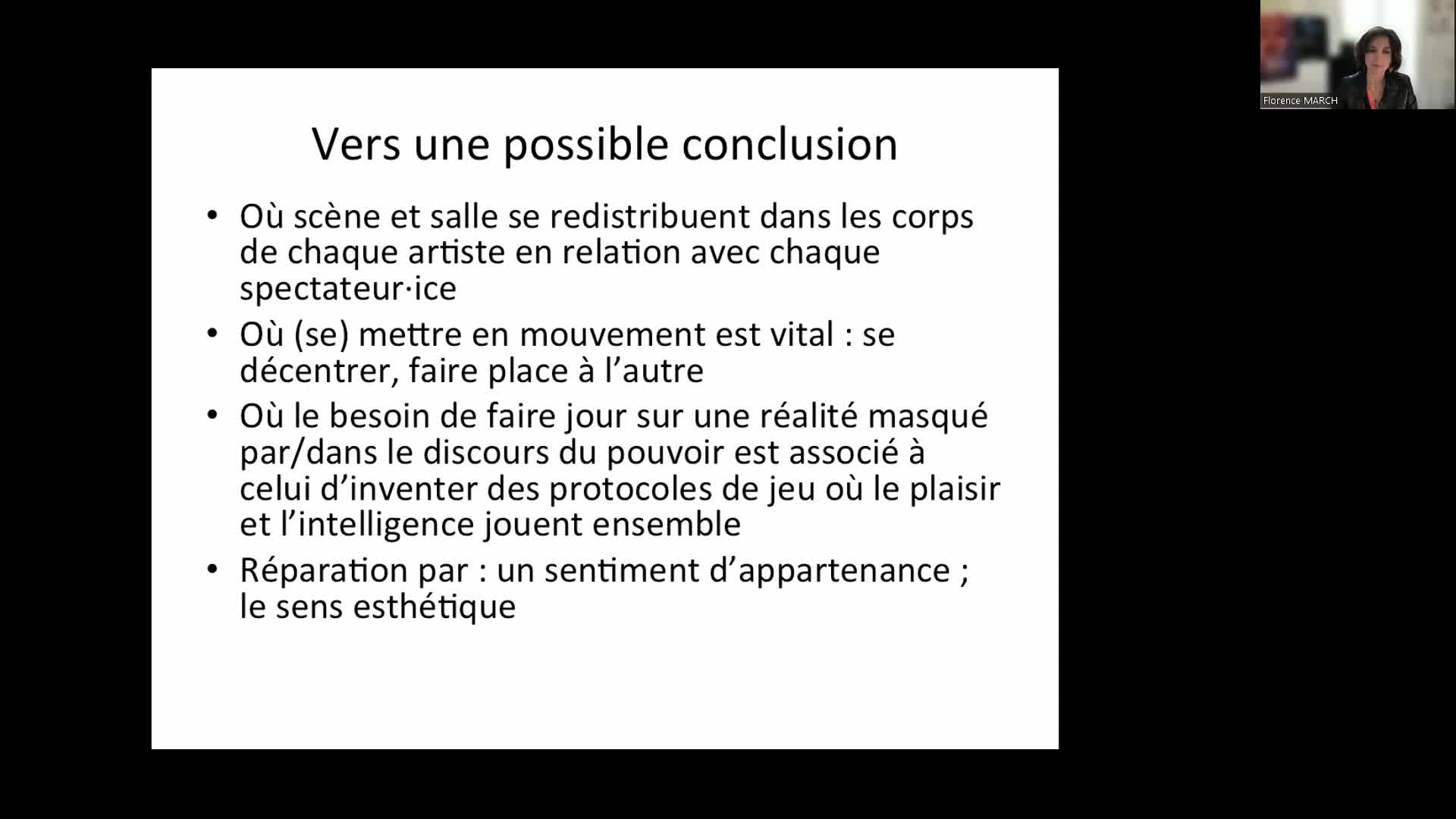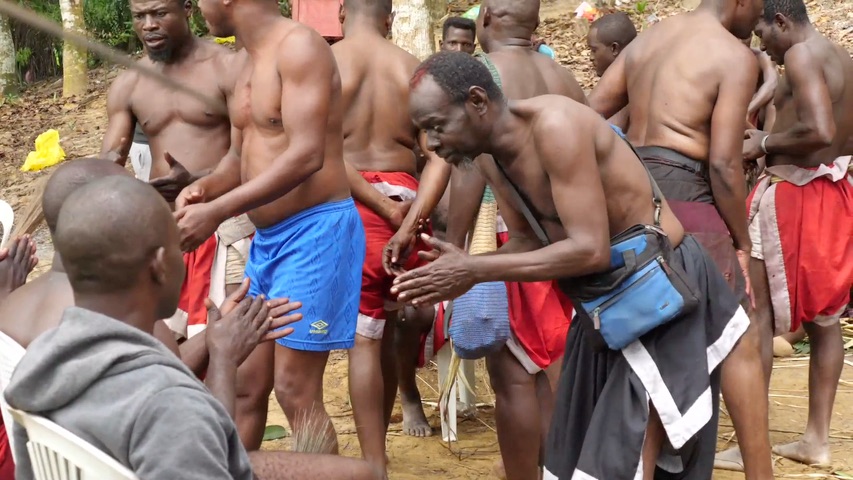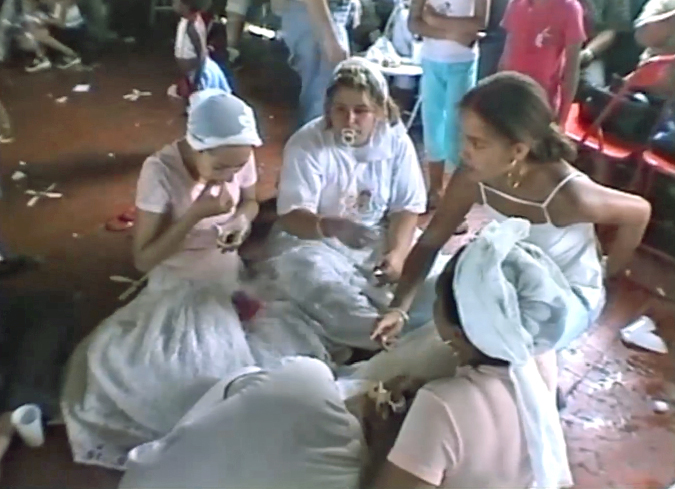Notice
Improvising in Sign Language and Gestures
- document 1 document 2 document 3
- niveau 1 niveau 2 niveau 3
Descriptif
The Sign Language Theatre Laboratory is a practicebasedartistic research group that began operating in2014 as part of the Grammar of the Body (GRAMBY) Interdisciplinary Research Project led by University ofHaifa linguist Wendy Sandler and funded by the European Research Council. Most of the nine Lab actorsare deaf and hardofhearing,and all of them use Israeli Sign Language (ISL) on a daily basis. We use ISLcombined with expressive gestures and physical theatre in order to develop a form of visual theatre that isaimed at both deaf and hearing spectators. Improvisation is our principal method of operation. We play withthe mimetic component of ISL, highlighting facial expressions and body language, and experimenting withgestures that are normally performed and understood by hearing and deaf people alike. We are inspired bydeaf culture as well as by the work of 20th Century theatre experimentalists such as Meyerhold, Artaud,Grotowski and the Living Theatre. We also draw from the language of two forms of traditional Indian dancetheatre, Kutiyattam and Kathakali, which employ combinations of codified hand movements (mudras) andfacial expressions (rasas) to present the dramaticaction. When our group was introduced to these genres in a workshop, we discovered a surprising affinitybetween the signs of traditional Indian theatre and those used in ISL. From this potpourri we devise ourtheatrical materials. We improvise within certain movement routines and exercises, realizing that free groupimprovisation can only stem from clear, at times even rigid structures and rules. Also necessary, of course,are “comprehensive listening”, which deaf actors practice visually, the ability to lead and be led, and finally,the skill of contributing to a collective creation. These will be demonstrated in my presentation through ananalysis of a few short videos of our work.
Intervention / Responsable scientifique
Thème
Documentation
Liens
Dans la même collection
-
Joint Improvisation Meetings 2015
We understand joint improvisation as an artistic form involving two or more performers engaging in multiple real-time interactions: with each other, with the audience and with the emerging content.
-
“Quantifying JI” Short talk 1.2: Tommi Himberg - Mirroring improvised hand movements in a dyad
HirataHelena SumikoWe studied coordination and movement kinematics in a mirror game. 32 participants (18 f, 14 m; mean age 25.2 years, range 19–37) performed circledrawing and freely improvised hand movement mirroring
-
“Beneficial JI” - Short talk 2.1: Neta Spiro - Joint improvisation in music therapy: characterising…
SpiroNetaSome types of music therapy, such as Nordoff Robbins, involve improvisation by the client and therapist andthe relationship between the participants’ music making is prioritised. Some children with a
-
“Improvising together” Debate
“Improvising together” Debate
-
Joint Improvisation in Music and Dance: Some Preliminary Phenomenological Considerationson Improvis…
Magrin-ChagnolleauIvan"I have been a practitioner of soloandjointimprovisationin music and dance for a while. And I have alwayswondered what the main differences were between the two. What I am particularly interested in
-
-
Improvising Interaction
HealeyPatrickEven the most tightly scripted solo performances involve improvisation; the detailed execution of each note or word cannot be completely determined in advance. In joint performances the challenge of
-
Operationalizing Social Neuroscience through HumanHuman and HumanMachine Interactions
DumasGuillaumeHow are neural, behavioral and social scales coordinated in real time so as to make possible the emergenceof social cognition? Answering this question requires to study the dynamics of coordination in
-
Acting together without planning ahead?
SebanzNatalieExperiments on joint action have given us insights into the mechanisms that allow people to coordinate theiractions with each other, be it making music, dancing, or cooking a dish together. One key
-
“Quantifying JI” Short talk 1.3: Ashley Walton - Musical Improvisation: Spatiotemporal patterns of …
WaltonAshleyWhen jazz musicians perform an improvisational piece of music their behaviors are not fully prescribed in advance. Nonetheless their actions become so tightly coordinated and their decisions so
-
“Beneficial JI” - Short talk 2.2: Julien Laroche - Being together when time is improvised: interact…
LarraínPabloImprovising music toghether involves coping in realtimewith unprecedented patterns of behavior of another. The goal is to achieve and share a meaningful coperformance,and this is done by interacting
-
Going into the unknown in science and art
KeysersChristianScientists must grope into the undefined place beyond the known. So must improvisation theater actorswalking onto the stage with no idea what will happen next. Improvisation theater developed
Sur le même thème
-
Danse et handicap #1 - Danser et vivre les yeux fermés : aller au bout de ses rêves
HaustantFabienneDanse et handicap #1 - Danser et vivre les yeux fermés : aller au bout de ses rêves
-
L'envers du décor: rhéthorique visionnaire et instrumentalisation politique dans l'art dramatique d…
LefrançoisFrédéricL'envers du décor: rhéthorique visionnaire et instrumentalisation politique dans l'art dramatique de Derek Walcott
-
Faire exister les nouvelles attentions : atelier de Julie Perrin et Pascale Gille
PerrinJulieGillePascalePar un atelier et une discussion, Julie Perrin et Pascale Gille soulignent comment les danseurs et danseuses continuent de faire bouger les lignes du "partage du sensible", en jouant de la frontière
-
Faire corps avec le document : les chorégraphes contemporains face aux crises et aux conflits
Cette communication se centre autour de pièces chorégraphiques qui abordent des situations de crises politiques, économiques, humaines, à travers des matériaux documentaires. Il s’agit de dresser un
-
Les formes de réparation dans les arts de la scène à l’épreuve de la Covid-19 (visio)
RiedlerJulietteBurighelGiuseppeLe webinaire propose un retour sur la journée d’étude et de pratiques artistiques " Les formes de réparation dans les arts de la scène à l’épreuve de la Covid-19 " (qui s’est déroulé le 23 mars 2022 –
-
Après la projection - Discussion autour de « Faraway My Shadow Wandered » de Liao Jiekai et Sudhee …
CheurfaCéliaJiekaiLiaoLiaoSudheeDiscussion avec les réalisateurs Liao Jiekai et Sudhee Liao, en dialogue avec Jean-Michel Butel, ethnologue, maître de conférences à l'Inalco, spécialiste des évolutions sociales et des structures
-
-
Cérémonies et rituels de l’umbanda : la fête des enfants Marília, État de São Paulo Brésil, les 13 …
JacquemotArmelleTerreiro du Vieux-noir Pai Fabiano, Marília, État de São Paulo (Brésil), les 13 et 14 octobre 2001
-
Corps dansant et corps bourgeois : la fabrique des normes au XIXe siècle
MarquerBertrandJarrasseBénédicteConférences | Vendredi 15 novembre Bertrand Marquer | La norme et l’écart : imaginaire et savoirs du corps au XIXe siècle Bénédicte Jarrasse | Corps-machines : la danse et l
-
-
-














